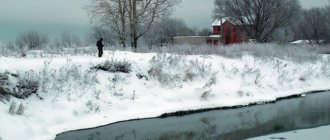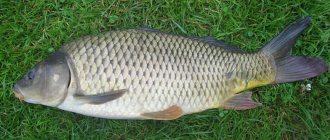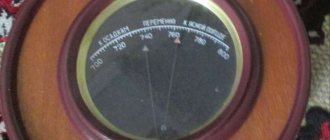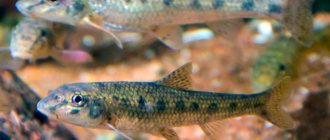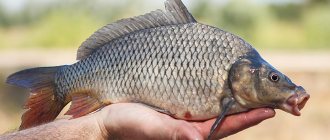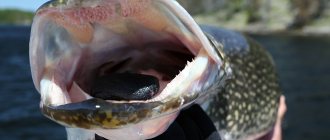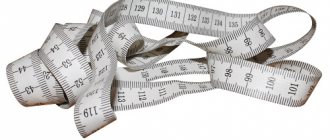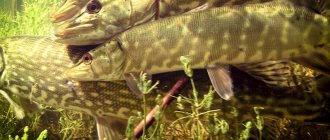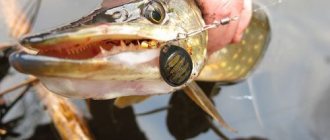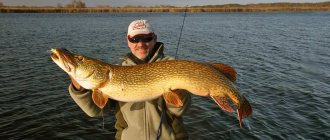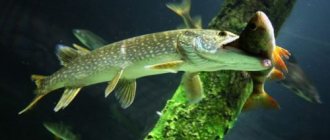Pike are very territorial and will attack anything a fisherman throws at them, so the trick is to identify where they are standing.
- Dependence of the bite on the time of day
- When to fish at different times of the year?
- Recommendations
The most desirable and beloved predator, which can reach impressive sizes, is very well caught on spinning tackle in spring and summer. Depending on the time of year, fishing spots also change. Moreover, with pike it is worth taking into account at what time it was decided to go fishing if you want to leave with the catch.
During the first zhora (before spawning), pike rushes to any artificial bait. At the same time, the predator is slow after a long winter, so it will not chase fast-swimming prey. And it will not attack large fish; it is better to use small baits. At this time, the water is often cloudy, which means there is no need to imitate forage fish; instead, you need to create a sound imitation of the fish. Wobblers and spinners are suitable for this.
Time of day for successful fishing
In the spring, when fishing from the shore, a short spinning rod is suitable; it will be easier for them to accurately cast the bait. The best option would be a medium-fast action rod, no more than 2.5 meters long for a small river, and from 2.7 to 3.0 for a large lake, with a test weight of 10-30 grams. The reel fits 1000-2000 sizes. As the main fishing line, use thin braid from 0.08 to 0.1 mm and a steel leash 15-20 cm long.
On small lakes and rivers, the most accurate will be a side or pendulum cast, when the bait flies a short distance and trees do not interfere with the cast. If you need a medium-range cast and there are no tree branches overhead, then perform a vertical whip cast.
Retrieving should be done slowly, especially on a lake where pike are less active than on the river. Move around as much as possible, fish all promising spots, try different baits.
Do the hook immediately - short and sharp. And do it at any suspicious blow.
If the pike feels small, then you should fish it out by quickly pulling it to the shore. Larger specimens must be fished out carefully - otherwise the line may break or the upper part of the rod will break. If you come across a real trophy, then you need to use the pumping method - the fish is pulled to the shore, then the reel is reeled in until the line is tensioned and pulled in again until the fish is near the shore, where you can pick it up with your hands.
During the first zhora (before spawning), pike rushes to any artificial bait. At the same time, the predator is slow after a long winter, so it will not chase fast-swimming prey. And it will not attack large fish; it is better to use small baits. At this time, the water is often cloudy, which means there is no need to imitate forage fish; instead, you need to create a sound imitation of the fish. Wobblers and spinners are suitable for this.
Let's look at the baits in more detail.
Wobblers are best suited for fishing in shallow water. Pike respond especially well to “Minnow” 5-8 cm long. Wobblers are carried out using a standard twitching retrieve with the addition of pauses of 2-5 seconds, and also using the “stop and go” type, when a uniform retrieve alternates with pauses of 2-3 seconds.
Jig fishing will give results when the pike stays at depth. Twisters and vibrotails should be 5-8 cm in size. The weight of the jig head is selected based on the strength of the current, usually 10-15 g is suitable. Jig baits are carried out using the usual stepped wiring. The rewinding speed should be slow or medium, with long pauses. Dragging along the bottom can also give results.
Poppers work well in May when aquatic vegetation is present. The wiring should be of the twitching type, only the jerks will be more frequent and sharp.
If the day is hot, then the pike, after the morning hunt, goes deeper and hides in cool water. Therefore, it is not possible to catch it in shallow water. Two hours after sunrise can still bring good luck, and in the hottest sunshine you need to look for it in the pits, but success is not guaranteed.
Best time to catch pike
As fishermen say, the whole life of a pike is hunting. Consequently, at any time of the year, the toothy hunter herself can fall on the fisherman’s hook.
Therefore, you can catch pike in spring, summer, autumn, and winter. Except for a short break for spawning and post-spawning leave.
Pike on a spinning rod
Spring, summer, autumn and winter
It is most convenient to open the pike fishing season before it begins to spawn. This is an early spring that comes to different regions at different times. Therefore, it is better to focus on the water temperature. As soon as it warms up to 7-8 degrees, the pike is ready to spawn. It lasts on average 10-14 days (give or take), during which pike fishing is prohibited by law. You need to wait two to three weeks until the fish recovers from spawning and goes hunting again in order to gain strength after a long winter and grueling spawning.
In summer you need to go pike fishing on cool days; in the heat it is in a sleepy state and luring it to the surface is not an easy task.
The second peak period favorable for fishing is the autumn zhor. At this time, the pike is preoccupied with accumulating strength and nutrients for the winter, so it is ready to swallow any bait.
Everyone likes to fish for pike
In winter, pike are searched for in ice holes; they are active on frosty snowy days.
With the end of the spawning ban, one of the most favorable times for pike fishing begins. Spawned white fish actively feed in the coastal zone of reservoirs, and pike do not stray far from it. Right now, when the coastal vegetation has not yet risen, coastal fishing can show excellent results.
Among the huge variety of predatory fish that live in fresh water bodies, pike is the most popular fishing object among amateur fishermen. Quite large size, omnivorousness, aggressive bites and desperate struggle during fishing - all this makes the hunt for this predator interesting and exciting.
With the end of the spawning ban, one of the most favorable times for pike fishing begins. Spawned white fish actively feed in the coastal zone of reservoirs, and pike do not stray far from it. Right now, when the coastal vegetation has not yet risen, coastal fishing can show excellent results.
What is the best time to catch pike?
Regardless of the time of fishing, the most promising are jig fishing and hunting for pike using surface lures.
Catching pike with a jig
Catching pike with surface baits
Unlike the spring season, when the “toothy” biting peaks in activity, summer is marked by short outings of the small predator. On clear, hot days, as a rule, mostly small fish up to a kilogram are caught, with rare catches of heavier trophies. The bite is observed early in the morning, until the sun begins to get hot and the wind rises. The hot part of the day rarely produces results, but activity resumes before sunset and lasts no more than an hour.
The influence of atmospheric pressure on biting
Pike biting at high atmospheric pressure
The activity of pike, with increasing atmospheric pressure, is observed only at a certain moment when it begins to rise. But this does not last long, and with a further increase in pressure, her bite becomes apathetic or disappears. But if such pressure remains unchanged for some period, then the predator adapts and the bite begins again.
Regardless of the fact that high atmospheric pressure is not a good factor for good fishing, those who like to catch predators even in such weather conditions are not left without a trophy. You just need to choose the right fishing time, place and bait. When pressure is high, the weather is usually sunny and clear. The best time for hunting is early in the morning or late in the evening, because pike do not really like this weather. At high pressure, the predator stays closer to the surface, but also likes to sit in ambush, so the optimal place to catch it is in various thickets. During these periods, pike prefers small prey.
Pike biting during periods of low atmospheric pressure
It is believed that the most favorable pressure level for catching this predator is stable and low. It is usually accompanied by rain, which is favorable for pike, since it does not like heat. With such pressure, small fish try to go deeper, thereby ending up close to pike ambushes. This happens because the density of water increases. And with its high value and cloudy weather, the predator will practically not find any differences between the spoon and the small fish.
Low pressure is a positive factor, but not a guarantee of effective fishing.
Many conditions influence the pike bite. The place of fishing is the depth, since that is where the predator’s prey is located. But she does not pursue prey throughout the reservoir, but waits in ambush. Therefore, the places to catch it will be: deep holes;
thickets of vegetation, deep-sea debris, beaver dumps. Among the variety of baits used are spoons, wobblers and vibrotails. When the pressure is low, pike prefers to hunt for larger prey, so the bait itself should be larger. And the colors of the baits should be similar in appearance to the predator’s potential victims (on a cloudy day it is necessary to select darker and more matte baits).
Important! The activity of pike decreases when the pressure changes by 2–3 mmHg, but it still continues to be caught. And with more noticeable differences, the bite usually worsens or stops altogether.
Optimal atmospheric pressure
The optimal pressure for catching predators is a stable low pressure that does not change for several days. It is more typical for autumn, but is rare for other times of the year. But the pressure can jump even during one catch. If the area is at sea level, then the normal pressure is 760 mm Hg.
As the area rises above sea level, every 10.5 meters the mercury column value must be lowered by 1 mm. The pike gets used to the pressure level. Therefore, when it remains at a high level for several days, the fish adapts and begins to behave as usual. And it will be possible to observe an active bite. At low pressure, small fish are passive, so the retrieve must be slow when fishing with a spinning rod, otherwise the predator can be scared away.
How to determine atmospheric pressure while fishing?
Atmospheric pressure changes over time. It is impossible to guess how it will change after a certain period of time, and even forecasts will not be very helpful.
There are some signs by which you can determine changes in atmospheric pressure. Water can tell you this if you watch it carefully. The water hardly sways from the wind and seems oily - this happens when the pressure decreases.
Smoke from a fire at low pressure spreads along the ground, therefore, when it is high, the smoke rises in a column. Also an indicator of decline is the morning fog spreading along the ground and clouds that gather on the horizon.
If during rain there is foam from small air bubbles near the shore, then this also indicates a decrease in pressure.
However, the most reliable method for determining atmospheric pressure is a barometer. But not everyone wants to take it with them fishing. Therefore, it is possible to purchase a wristwatch with a built-in barometer.
Pike fishing in spring
Unlike the spring season, when the “toothy” biting peaks in activity, summer is marked by short outings of the small predator. On clear, hot days, as a rule, mostly small fish up to a kilogram are caught, with rare catches of heavier trophies. The bite is observed early in the morning, until the sun begins to get hot and the wind rises. The hot part of the day rarely produces results, but activity resumes before sunset and lasts no more than an hour.
If you manage to predict a cloudy day, the predator will bite successfully throughout the entire fishing trip. The best weather for pike fishing in summer is cloudy, with a slight breeze, and stable atmospheric pressure. Often the largest specimens were obtained in the rain. The natural exchange of water saturates the water area with oxygen and activates its inhabitants.
It is worth noting that a strong gusty wind does not promise a rich catch, because it is impossible to make accurate casting and retrieving in such conditions. A waterproof raincoat, a spinning rod with a high test limit and heavy baits will help you cope with natural phenomena.
If you were unable to catch the moment in the morning, you can go fishing in the evening, but the chances of catching a trophy will be lower.
Moments of wind influence on pike fishing
The wind direction itself does not have a strong influence on the pike bite. Wind speed plays an important role here. It is necessary to take into account the characteristics of the reservoir and try to choose a position in which the wind would blow either from the back or from the side. If fishing is carried out from a boat, then it is best to opt not for clean water areas, but for bays covered with reeds on all sides.
Wind gusts up to 5 m/s are more preferable. It perfectly saturates the water with oxygen, which in turn makes the fish much more active. To make fishing easier in gusts of wind, it is best to choose a heavy rod with massive rigs.
In conclusion, we note that it is possible to catch such a predator as pike at the Sazanya Bay fishing base in almost any weather conditions. Take a look at the “Fisherman’s Calendar” page to accurately determine the time period for pike fishing, and experienced huntsmen will tell you where to cast in order to return home with a rich catch.
TAGS:
How to catch pike at lunchtime and in the afternoon
At midday, the pike often calms down and heads to grass thickets or to deeper areas of reservoirs; especially if it's hot outside.
When looking for an answer to the question of when is the best time to catch pike in the summer, it is worth taking into account the fact that in the second half of the day the upper layer of water in the reservoir warms up a little, which is why the predator becomes lazier. As a result, it becomes increasingly difficult to catch.
Pike fishing during the day can be done using spinners. The trolling technique can also work well at this time. In general, fishing for pike during the day can bring a catch, but in the daytime context, it is at this time that the chances are minimal.
True, this does not apply to cloudy weather or days when it is drizzling, creating small ripples on the surface of the reservoir. In such conditions, the question of when is the best time to catch pike loses its relevance, since at any time there is a high probability of catching large individuals.
In spring, it is preferable to choose balancers, spoons, wobblers, and also add living creatures, such as a worm, to the bait.
When does pike start biting in the spring?
The bite may depend on various reasons. One of them is how cold the winter was, and how quickly spring came to replace it.
In the spring, fish try to satisfy their hunger after winter; the ice has not yet melted, but it is already approaching the surface and appears at the gullies and mouths of shallow rivers. During this period, the pike attacks any food that appears in sight.
Approximately, the beginning of the pike bite can be designated as the beginning of March. If the winter was normal, then in the first days of this month you can catch a seasoned predator, which is unlikely to be caught in the summer.
The guideline for starting to catch this fish can be considered the convergence of ice.
When to go pike:
- since morning;
- in the evening;
- On cloudy days you can fish even at noon.
They hunt in May with a spinning rod, but fishing with a float rod will be more interesting. With the help of live bait you may be lucky to catch a large predator.
Reviews from fishermen
The first attempts at catching pikes did not end in success, so I changed fishing spots very often until I found a suitable one. I would like to give advice to fishermen not to give up trying after unsuccessful attempts, you just need to be careful and everything will work out.
Vladimir. 35 years
Before hunting pike, you should carefully prepare. You need to know where it bites, suitable baits, and also what time of year and day it is advisable to go fishing. Proper preparation allows you not only to get positive emotions from the process, but also to please yourself with a successful catch.
Pike fishing depending on the time of year:
When does the pike zhor begin?
The spring feeding season for pike begins in March-April. It all depends on the weather. If March is too cold, this period will begin in early April. Let's consider 3 types of zhor depending on the month:
- March. Most often, fishing during this period is carried out from ice. Fishermen mainly use girders or artificial baits. If there is a strong current near a river or lake, gullies already appear in March, which will allow you to fish with a spinning rod.
- April. At the beginning of the month, there may still be ice cover on reservoirs. But there are also areas with open water. Consequently, in April they fish from the shore and with spinning rods. Fishing from a boat is also a good idea. But we must not forget about the ice sheets. You can cast to the edge of the ice, pulling the bait into the water. But the most effective fishing is from the shore. It is important to note that in April you can get to both the pre-spawning and post-spawning food for pike in the spring.
- May. The post-spawning feast begins. It is better to fish from a boat, but the prospects are also good from the shore.
Pre-spawning zhor
There are several periods called zhor. The very first one is spring. It occurs before spawning. As soon as severe frosts end, fish activity increases. This usually happens in March. Sometimes there is even ice on the water at this time. However, pike are still preparing for the April spawning. That is, zhor occurs from early March to April. This is a good time for open water fishing. As soon as spawning begins, the predator will stop feeding, that is, it will not fall for the bait.
Although the fish are hungry after winter, they are not very active at first. It will take some time for the fish to start feeding intensively. The pike's hunger increases gradually. The maximum peak occurs right before spawning, that is, in mid-April. But it happens earlier if the ice breaks early.
Read more about the tactics and methods of catching pike in the spring.
Post-spawning zhor
Immediately after spawning, the predator is unlikely to be interested in food. She gets sick, so she becomes less active. It is important to note that the zhor before spawning is more pronounced than after it. After the pike recovers from the spawn, it will become more active. After all, the fish has spent a lot of energy and needs to recover. It takes about two weeks for pike to get back into shape. Afterwards she returns to her usual diet.
The post-spawning feast lasts a couple of weeks. Usually this time is enough for the fish to get into shape. Now the pike will feed as usual. You can’t expect such activity until the water cools in the fall.
How to catch pike?
There are many ways to catch pike.
Some of them have been used since time immemorial, others have come into use quite recently.
Zherlitsy
This is the simplest and not at all sporty way. There is no fight against a predator, but there is a simple everyday calculation. Using it, the fisherman attaches to a tree at night (in shallow water to a pole stuck in the sand) a wooden flyer with a fishing line wound around it.
The fishing line is fixed in a split at the end of the flyer, a sinker is hung from it, and live bait is attached to the hook. It is important to choose the right place to install the trap. It is most often placed over a pool or over a place where there are bottom anomalies - that is, a potential refuge for a predator.
At night, attracted by the fluttering of the bait, the pike leaves its ambush and gets hooked, after which you can safely cook fish soup from it.
Mugs
This is also a very old way. With it, the fisherman uses foam or carved wooden circles wrapped with 10 meters of fishing line. Using a specially planed stick, the fishing line is attached to the part of the circle that is above the water.
To its other end, on the hook, a sinker and live bait are attached. With this bait, the fisherman has to stay nearby. As soon as the pike catches on it and pulls, the fishing line will begin to unwind, the pike will be firmly planted on the hook, and all that remains is to pull it out of the water.
The advantage is that the circles themselves look for prey - the live bait attached to the circle behaves as naturally as possible and simply pulls the circle along with it where instinct tells it.
Pike fishing rod
This is an ordinary small float fishing rod, which is equipped with guide rings and a reel.
A live bait is attached to it, and a champagne cork is used as a float so that the live bait cannot drown it on its own. It is also important to pay attention to the leash - it must be made of material that is resistant to sharp pike teeth, otherwise the predator will simply tear it off and swim away with the hook.
You can use special wiring - metal, invisible - or you can limit yourself to a thin fishing line folded in half.
Pike fishing rods are good in small rivers overgrown with reeds and reeds, as well as on overgrown lakes, where you have to cast into clean windows between water lilies and algae. They fish with it using the walking method - moving along the shore of the reservoir, they estimate by eye where the prey might be, and cast the fishing rod.
— the pike’s mouth is sharp, which easily damages the fishing line, so it is worth using the most reliable gear when fishing;
